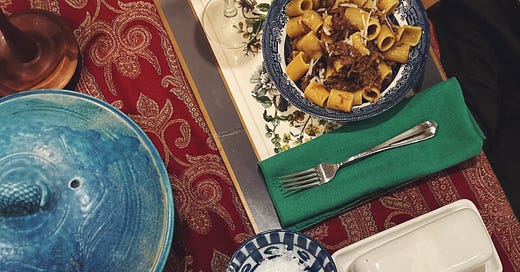Last year Jackson and I enjoyed a lovely bowl of pasta at Macosa, the closest thing I have to a neighborhood restaurant. It was a tomatoless (“white”) ragu, threads of braised beef and melted onions tangled into rigatoni. It had a perfect softness to it: the beef and the onions had almost achieved the same texture, tender and diaphanous.
A few weeks ago, Jackson sent me a recipe from his favorite food blog1 for pasta genovese, an iteration of that same ragu. We made it while we were up in Massachusetts with a large kitchen at our disposal, and once we were halfway into cooking it, I realized the sauce’s fascinating trick: the beef braises in the onion liquid. You render some pancetta (we used bacon), sear some beef chuck, cook a carrot and a stalk of celery until they’re soft. Add a whole cup of wine, cook it down. Standard stuff. Then you add five pounds of chopped onions, and some water, and the beef, and pop it right in the oven. You do not brown, sauté, caramelize, or soften the onions. You let the gentle heat of the oven leech out their water, which cooks the beef and turns it tender and sweet. After three hours, you move the pot to the stove, take out the beef, and cook the onions until the liquid evaporates and they begin to caramelize. This is, I think, the “reverse-sear” of caramelized onions. I won’t say it takes less time, but there is something less annoying about it. You don’t have to hover over the pot until the last minutes, as you track the level of brown you want your wisps of onions to be. You finish by shredding the meat into the onion sauce, though Jackson kept telling me about how some Italians serve the meat as its own dish, with just the onion sauce dressing the pasta.
The resulting sauce is incredible, just as good as the restaurant version. (It reminds me a bit of the Smitten Kitchen short rib onion soup, though much cheaper to make, lighter from the white wine, and a little less laborious.) I insist on serving it with rigatoni—I find penne loathsome. It barely needs cheese.
When making a big pot of ragu, I like to boil my pasta fresh each night, but the second night we ate this we had friends over, and some leftover pasta remained. I generally take no issue with cold pasta unless it is trapped, aspic-like, in a congealed fatty sauce. I often follow the advice of Tamar Adler, who recommends letting pasta sit at room temperature for an hour or two to remove the tense chill of the fridge and let the noodles relax.
Reheating pasta is always a dangerous enterprise that risks mushy noodles. Sometimes I’ll almost fry my leftover pasta, letting its edges crisp in a bit of hot oil, leaning into the promise of bite. A microwave can work, but I don’t have one. With a meat sauce as lovely as this one, it felt wrong not to eat this hot, and I didn’t want to add more fat. So I found a new way, which I’ve begun to adopt for most of my leftover pasta.
Keep reading with a 7-day free trial
Subscribe to Mess Hall to keep reading this post and get 7 days of free access to the full post archives.




